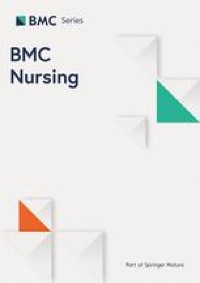
Pain is one of the commonest complaints presented to nurses and they are expected to have adequate knowledge and favorable attitude towards pain management [7, 15]. In the current study, good knowledge was observed among 67.1% of nurses which is comparable to previous studies that reported 60.0%, 61.1%, and 66.8% of nurses had good knowledge [11, 16, 19]. However, it is relatively higher than previous findings which reported 41.0%, 48.2% and 58.6% of nurses had good knowledge [8, 18, 20].
Moreover, we have observed favorable attitude towards pediatric pain management among 209 (89.3%) nurses and the median (IQR) of attitude scores was 54 (51–55) which is comparable to previous studies [17, 18]. However, these results are superior compared to previous studies in which over the half of nurses found to have unfavorable attitude [4, 12, 13]. The differences might be explained as due to large proportion of nurses (91.1%) who held Bachelor’s Degree or above were included in our study. Inclusion of nurses non-specific to pediatric care areas in the previous studies and utilization of different assessment tools might also explain the discrepancies.

The majority of nurses (93.6%) responded that children need better attention for managing their pain; 92.3% believed that pain assessment must be considered as vital sign examination and 81.6% agreed that full treatment of pain is a humanitarian issue. However, only 17.1% of nurses correctly answered that infants and children experience pain equal to that experienced by adults which is consistent to a previous study [21]. Moreover, 46.2% of nurses agreed to the statement “when the necessary procedures have been done for the patient, the persistence of pain does not cause problems.” In previous misconceptions, it was thought that infants did not feel pain because of an immature nervous system. Neonates and infants feel pain; even, react to noxious stimuli with distress indicative of pain [22].
Seventy-four (31.6%) nurses believed that narcotics on regular schedules are not preferred options for continuous pain. Consistently, a previous study found out 37.8% of nurses believed that patients should be encouraged to endure as much pain as possible before using an opioid [23]. Furthermore, another study also reported low rate of correct answers (30.8%) for the questions regarding opioids [14]. Trends of overestimation of opioids as dangerous drugs made clinician reluctant to use them. Side-effects and abuse of opioids has limited their use and led to inadequate information and attitudes towards opioids. Provision of training focusing on opioid use may enhance correctness [23].
Regarding use of non-pharmacological approaches of pain management, about 85.0% of nurses confirmed that distraction by use of music or relaxation decrease feeling of pain. A previous study found that 60.5% of nurses incorrectly believe that if a child can be distracted from pain it is not severe. 79% erroneously believe that children with severe pain will not be able to sleep. Effective use of non-pharmacological approaches needs better understanding of childhood behavior and pain responses [4].
About 74.8% believed that the patient is the accurate judge of the intensity of pain. However, previous studies showed that more than half of nurses incorrectly answered the item ‘‘The most accurate judge of the intensity of the child’s pain is the child’’ suggesting that a child’s self-reported pain is not trusted by nurses as reliable during assessment practices [4, 15]. Evidences suggested that self-reported tools can be reliably used by children as young as three years [24, 25].
Our study revealed that having Bachelor’s Degree or above in Nursing was associated with both good knowledge and favorable attitude compared to have Diploma in Nursing. When nurses have a minimum of Bachelor’s Degree in Nursing, the odds of having good knowledge and favorable attitude were double [AOR = 2.1, P = 0.015] and triple times higher [AOR = 2.8, P = 0.03] respectively. Consistently, previous studies declared that higher educational level was associated with good knowledge and favorable attitude towards pain management among nurses [6, 15, 18, 23, 26]. However, there are previous studies that stated no significant association between level of education and knowledge and attitude [12, 13]. This finding might be explained by bigger contents concerning pain management in the curricula for higher Degree programs (Bachelor’s and Master’s) compared to that of Diploma programs.
Nurses who have had in-service training on pain management were found to be knowledgeable more than twice [AOR = 2.4, P = 0.008]. Previous studies have reported that lack of training resulted in inadequate knowledge and affected the provision of pain management. In-contrast, education and training on pain management enhanced knowledge and practice of pain management [23, 27]. However, a recent study has reported no significant differences were identified for the exposure to previous pain education and explained it by the shortage of quality continuing medical education courses on topics of pain management [12].
Knowledge and attitude are inter-related entities that influence one another. In the current study, nurses who had favorable attitude were found over triple times more knowledgeable [AOR = 3.3, P = 0.008]. In-reverse, nurses who had good knowledge were found to have favorable attitude [AOR = 3.3, P = 0.007]. Similarly, higher knowledge was correlated to more positive attitude towards pain management and suggested that knowledge levels need to be improved to ensure more positive attitude to pain management [22]. However, there are studies that showed knowledge and attitude can be independent of one another suggesting nurses may have favorable attitude towards pain management with inadequate knowledge [17, 19].
Our findings denied the associations of nurses’ age, sex, work experience, and units with knowledge and attitude towards pediatric pain management which is consistent to some previous studies [13, 16, 23, 26]. Even though, a previous study has found significantly higher mean score of knowledge and attitude among female nurses [12].
The limitations of this study are; due to its cross-sectional design, it could not draw temporal relations; and it does not have qualitative components that might enable to explore barriers and root-causes for ineffective pediatric pain management. Furthermore, the study was conducted only in the tertiary hospitals in the region. It did not include lower healthcare facilities that could lack resources and expertise for pediatric pain management. We expect more exaggerated problems in pediatric pain management in those facilities.




